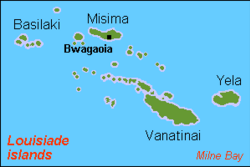Misima Island
Nickname: St. Aignan Island | |
|---|---|
| Area | 215 km2 (83 sq mi) |
| Length | 40 km (25 mi) |
| Width | 10 km (6 mi) |
| Highest elevation | 1,036 m (3399 ft) |
| Highest point | Mount Koia Tau or Oia Tau First Recorded Ascent:24 December 2016 by Kolbe Bare and two other Misimans |
| Administration | |
UTC+10) | |
| ISO code | PG-MBA |
| Official website | www |



Misima (formerly called St. Aignan) is a volcanic island in the northwest of Louisiade Archipelago within Milne Bay Province of Papua New Guinea.
History
Misima Island was inhabited by Austronesians since about 1500 BC. The island was sighted in 1768 by French captain Louis Antoine de Bougainville and explored 1793 by French explorer Antoine Bruni d'Entrecasteaux. Misima island owes its name to Élisabeth-Paul-Édouard de Rossel, which was a lieutenant of the Counter admiral Antoine Bruny d'Entrecasteaux during his journey of scientific exploration. In 1888 the
Gold was discovered on Misima late in 1888.[2] By March 1889, eighty men were on the island digging for gold, and a storekeeper had set up a business.[3]
Since 1975, Misima belongs to the independent state of Papua New Guinea. A gold and silver mine was opened on the island in 1990, by an international corporation. The mines provided plenty of work for the islanders. however, that mine was officially closed in 2004, because of excessive load on the environment and public health hazards.[4]
Politics
The island is within the Samarai Murua District.
Geography
The island measures 40 by 10 km (24.9 by 6.2 mi) and has an area of 2,145 km2 (828 sq mi). It is located some 20 km (12 mi) north of the northwest extreme of the barrier reef of
Misima is mountainous and densely forested. Mt. Koia Tau, at a height of 1,036 meters (3,399 ft), is the highest peak of the Louisiade Archipelago.
It was not until 24 December 2016 when Kolbe Bare, a Papua New Guinean geologist, and two Misimans, David Kaliton and Kaliton Ada, made the first recorded ascent to the Top of Oia Tau. It was noted by Kolbe that even though the mountain is close to the sea, Higher altitude vegetation covers the top of the mountain at the time of ascent.
Climate
The local climate is
Economy
Misima island is known as a mining island. A huge mine operated many years on the island. The mine was a joint venture by
Since 2004 when the mine closed,
. A commercial fisheries project has been proposed, but has not been developed yet.Demographics
The island has a population of 19,330, spread across 78 villages, Misima is the most heavily populated island in the
Urbanization
The main town of the island and the seat of the district is Bwagaoia, located on the southeast corner of the island. Other villages are Hinauta, Boiou, Gulewa, Bagilina, Liak, Siagara, Eiaus (on the eastern north coast, reachable by road from Bwagaoia), Gulewa and Ewena (on the western north coast), and Bwagabwaga, Gaibobo and Alhoga (on the south coast).[5]
Cities
Religion
About half the population identified themselves as members of a Christian church. see Religion in Papua New Guinea for more info.
Language
The main language of the island is also called
Culture
This section is empty. You can help by adding to it. (August 2017) |
Education
- Bwagaoia Primary School
- Misima Secondary School formally Misima High School
- Siagara Primary School
- Liak Primary School
- Patnai Primary School (Bwagabwaga)
Transportation
Misima Airport Closed. Only Means of transportation out of the island is by sea. News article https://www.postcourier.com.pg/png-air-suspends-all-flight-to-and-from-misima-airport/ Update: 3Million KINA airport upgrade https://www.thenational.com.pg/k3-million-for-misima-airport-upgrade/ locals still traveling by sea date 3rd of January 2024. (Misima has a working
Flora and fauna
The following mammals are present on Misima Island:
- Polynesian rat (introduced)
- Wild boar (introduced)
- Eastern common cuscus
- Sugar glider
- Grassland rat
- Eastern rat
- Panniet naked-backed fruit bat
- Island tube-nosed fruit bat
- Small flying fox
- Common blossom bat
- Temminck's trident bat
- Spurred roundleaf bat
- Fawn leaf-nosed bat
- Diadem leaf-nosed bat
- Smaller horseshoe bat
- Misima bat
- Little bent-wing bat
- Miniopterus macrocneme
- Great bent-winged bat
- Common bent-wing bat
- Angulate pipistrelle
Other animals:
References
External links
- Mine Report Archived 9 May 2013 at the Wayback Machine
- Misima Island News at MisimaIsland.com
- [1]
- [2]
